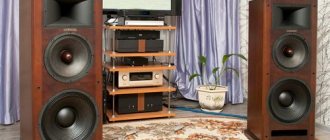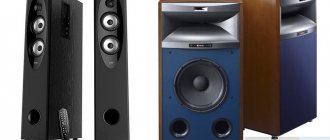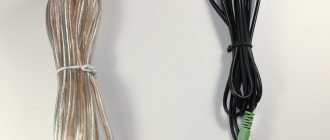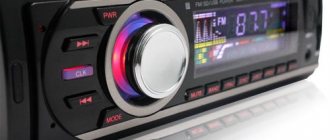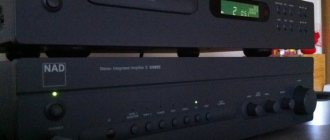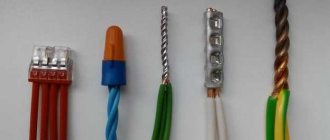In the previous guide for beginning music lovers, dedicated to room acoustics, we found out that any room is a kind of resonator that dramatically affects the sound character of the system. Now it’s time to talk directly about the sources of this very sound, that is, about speaker systems.
In order to properly understand the processes occurring in a box on the wall of which one or more speakers are mounted, you need to thoughtfully read a couple of books, each of which contains more formulas than the entire school physics course. I won’t go into such depths, so this material is not worth it as a comprehensive analysis or guide to building audiophile speakers. However, I really hope that it will help beginning music lovers (and some chronic ones too) to properly navigate the variety of acoustic solutions, each of which its developers, of course, call the only correct one.
For some time after the invention of the electrodynamic emitter with a conical diffuser (okay, just dynamics) in 1924, its wooden frame served primarily decorative and protective functions. This is understandable - after many years of listening to records through mica membranes and gramophone bells, the sound of the new device, even without any acoustic modifications, seemed simply the apotheosis of euphony.
Gramophone membranes were most often made of aluminum or mica
However, recording technologies quickly improved and it became clear that it was extremely problematic to more or less plausibly reproduce the audible range with a speaker simply mounted on some kind of stand. The fact is that the dynamic head, left to its own devices, is in a state of acoustic short circuit. That is, the waves from the front and rear surfaces of the diffuser, emitted, of course, in antiphase, seamlessly overlap each other, which most sadly affects the efficiency of operation, and primarily on the transmission of bass.
By the way, in the course of this story I will most often talk about low frequencies, since their reproduction is a key point in the operation of any speaker cabinet. Due to the short length of the emitted waves, HF drivers do not need to interact with the internal volume of the speaker at all, and are most often completely isolated from it.
Soul wide open
The easiest way to separate the front radiation of a speaker from the rear is to mount it on a shield as large as possible. From this simple idea, the first acoustic systems were born, which were a box with an open back wall, since for compactness the edges of the shield were simply taken and bent at a right angle. However, in terms of bass reproduction, the success of such designs was not very impressive. In addition to the imperfection of the body, the problem was also in the suspension travel of the diffusers, which was very small by modern standards. To somehow get out of the situation, speakers were used as large as possible, capable of developing acceptable sound pressure with a small vibration amplitude.
PureAudioProject Trio 15TB with 15" LF drivers on three-layer bamboo panels
Despite the seeming primitiveness of such designs, they also had some advantages, and they were so specific and interesting that adherents of open speakers have not died out to this day.
To begin with, the absence of any obstacles in the path of sound waves is the best way to increase sensitivity. This point is especially valuable for audiophile tube amplifiers, especially single-ended or feedbackless ones. Large-diameter paper diffusers, even at a power of about four to five watts, are capable of creating a rather impressive, and at the same time surprisingly open and free sound.
With a height of 1.2 m in the world of open acoustics, the Jamo R907 are considered almost compact
As for the rear radiation, in order not to introduce distortion into the direct sound, it must arrive to the listener with a noticeable delay (over 12-15 ms) - in this case, its influence is felt as a slight reverberation, only adding air to the sound and expanding the musical space . The subtlety is that to create this very “noticeable delay”, the speakers, of course, must be located at a fair distance from the walls. In addition, the large area of the front panel and the impressive size of the low-frequency drivers have a corresponding impact on the overall dimensions of the speakers. In a word, owners of small and even medium-sized living rooms, please do not worry.
By the way, a special case of open systems is acoustics built on electrostatic emitters. Only due to the almost weightless diaphragm of a large area, in addition to all the advantages described above, electrostats add the ability to delicately transmit even the sharpest dynamic contrasts, and due to the lack of signal separation in the midrange and treble zones, they also have enviable timbral accuracy.
Open design
Pros: High-end open-back speakers are a great way to get a real kick out of listening to purist tube single-ended speakers.
Cons: It’s better to forget about fat compression bass right away. The entire sound path must be subordinated to the idea of open acoustics, and the speakers themselves will have to be chosen from an extremely limited number of proposals.
An example of calculating the front panel of an open speaker system design
It is required to calculate the dimensions of the front panel of the open design with a depth of h=80 mm . for head 0.5GD-37 (see previous example).
Rice. 36. Frequency characteristics of the head in boxes of various shapes (the dot indicates the location of the head)
1. From (27) we find the cutoff frequency: frp.н = 1.4•343/3.14•0.08=1920 Hz ;
2. Using (31), we determine the resonant frequency of the head in an open design, taking into account its depth:
3. According to the schedule in Fig. 32 we find the lower limit frequency of the reproduced range at Q = 2.3 ; frp.n ≈ 260 Hz .
4. According to the schedule in Fig. 33 we find the difference between peak and trough levels: N=1.0 dB .
5. φ(Q)≈Q=2.3.
6. Using (32), we determine the area of the front design panel:
S=0.125•3432/(2602•2.32)=0.041 m2;
With a decay at frequency fgr.n equal to 6 dB , according to (30) we find that S = 0.02 m2 .
7. Select the front panel size to be 0.17×0.12 m2.
Back to the main page … | |
Locked in a box
With the increase in power and improvement in amplifier parameters, the ultra-high sensitivity of acoustics has ceased to be the main stumbling block, but the problems of uneven frequency response, and especially the correct reproduction of bass, have become even more pressing.
A giant step towards progress in this direction was made in 1954 by the American engineer Edgar Vilchur. He patented a closed-type speaker system, and it was by no means a gimmick in the style of today's patent trolls.
Edgar Vilchur's patent application for speakers is closed
By that time, the bass reflex had already been invented and, of course, a speaker was also tried on a box with a bottom more than once, but nothing good came of it. Due to the elasticity of the enclosed volume of air, it was necessary either to lose a significant part of the energy of the diffuser, or to make the body prohibitively large in order to reduce the pressure gradient. Vilchur decided to turn evil into good. He greatly reduced the elasticity of the suspension, thus transferring control of the movement of the diffuser to the volume of air - a spring that is much more linear and stable than a corrugation or rubber ring.
In a closed box, the diffuser's movements are controlled by air - unlike paper or rubber, it does not age or wear out
In this way, it was possible not only to completely get rid of the acoustic short circuit and increase the output at low frequencies, but also to significantly smooth out the frequency response throughout its entire length. However, a minor point also emerged. It turned out that damping with a closed volume of air leads to an increase in the resonant frequency of the moving system and a sharp deterioration in the reproduction of frequencies below this threshold. To combat this problem, it was necessary to increase the mass of the diffuser, which logically led to a decrease in sensitivity. Plus, the absorption of almost half of the acoustic energy inside the “black box” could not but contribute to the reduction in sound pressure. In a word, the new type of speakers required amplifiers of quite serious power. Fortunately, at that time they already existed.
Subwoofer SVS SB13-Ultra with closed acoustic design
Today, closed design is used mostly in subwoofers, especially in those that claim serious musical performance. The fact is that for home theaters, energetic development of the lowest bass is often more important than dynamic and phase accuracy throughout the low-frequency range. But by combining a relatively compact closed sub with decent satellites, you can achieve a much more correct sound - albeit not filled with super-deep bass, but extremely fast, collected and clear. All of the above can also be attributed to full-range speakers, “closed” models of which occasionally appear on the market.
Closed box
Pros: Exemplary attack speed and low-frequency resolution. Relatively compact design.
Cons: Requires a fairly powerful amplifier. Ultra-deep bass on the verge of infrasound is very difficult to achieve.
Audiofilkina certificate: educational program on acoustic design
The previous article on the closed box demonstrated that some readers have questions regarding the differences between different types of acoustic design. People wondered what a closed box actually is, how it differs from a bass-reflex design and from other types. The majority of survey participants responded that when purchasing speakers, in principle, they would not be interested in acoustic design.
I believe it would not be amiss to concentrate readers’ attention on the main strengths and weaknesses of various types of acoustic design and conduct a small educational program on this topic. This time I will not touch on too rare and exotic types, but I will try to describe in relatively detail the advantages and disadvantages of the most common ones. The part of the post dedicated to ZY is an answer to a question asked by lair, who was unclear why “Audiophiles and demanding rich people are spoiled by more sophisticated solutions, and the middle class is not ready to sacrifice the volume of small apartments.”
Briefly about the dependence of sound on the speaker cabinet
The acoustic design of the housing affects mainly the frequency response, as well as some other parameters.
Depending on the calculations and the chosen design, this influence can improve or worsen the fidelity of reproduction. Any solution in acoustics is a kind of compromise between practicality (and often aesthetics of form) and engineering solutions that seek to increase the fidelity of reproduction. The problem of fidelity of reproduction rests on the laws of physics that limit it; acoustic design is an attempt by engineers to reduce the influence of factors that impair fidelity of reproduction, while obtaining operational properties acceptable to the end user. I believe that most readers know that without design, the speakers will not sound correctly - the so-called. acoustic short circuit. The pressure wave reproduced by the speaker with a length commensurate with the dimensions of the diffuser is compensated by rarefaction of air from the rear side of the diffuser.
The ideal speaker system is an endless wall. If we do not touch upon the ideal area, then the path from the center of the outer side of the diffuser to its center on the back side of the diffuser should be more than half the maximum length of the emitted sound wave. Especially many problems arise here with LF. So, at 20 Hz (the lower threshold of perception) the wavelength is a little more than 17 meters. Naturally, a wall speaker of this size is somewhat large for a commercial series. For this reason, walls are not built, but boxes are preferred, which do not completely solve the problems, but can largely compensate for them.
Problems exist not only with acoustic short circuiting, but also with other speaker properties. For example, any speaker has a resonant frequency, below which there is a steep drop in the frequency response, approx. 12 dB per octave. When operating at a resonant frequency, a lot of harmonic distortion occurs. It is impossible to solve the problem of blocking the frequency response and nonlinear distortions by reducing the resonant frequency too sharply, since the huge amplitude of resonant oscillations will tear the diffuser.
It is known that the amplitude of diffuser oscillations is inversely proportional to the square of the frequency, i.e. with equal sound pressure at 50 Hz the amplitude will be 4 mm, and at 25 Hz -16 mm. Thus, the larger the diffuser, the lower the resonant frequency can be with vibrations that are relatively safe for the speaker. In other words, the lower the speaker's resonant frequency, the better.
Body resonances and shape
All speaker enclosures are volumetric resonators (whether it be an open box, FI, ZY or a labyrinth), which have a huge number of their own resonances. This is clearly visible from the formula for calculating resonances for a closed box: where a, b and l are the sides of the resonator body, and m, n and g are integers.
Resonances are determined by standing waves arising inside the body, which significantly affects the frequency response, as a rule, not in the best possible way. To remove them, the same dampers are used, which reduce the quality factor of the resonances, but do not completely remove them.
We can say that resonances directly depend on the shape of the body, or otherwise, on the aspect ratio. The shape that is common today in the form of a rectangular column is extremely unfortunate when it comes to body resonances. The cube shape, on the contrary, allows resonances to be spread throughout the entire frequency response and made less noticeable. For ZY and FI, a spherical body shape is also sometimes used, which prevents the formation of standing waves, but is also not able to completely eliminate them.
A few words about the open box
Despite the fact that today this design is difficult to find in mass-produced devices, it has one unique advantage.
An open box does not affect the resonant frequency of the speaker. It was for this feature that he was loved in the past. The big problem with an open box is its impressive dimensions. Without them, it is not able to reproduce low frequencies with sufficient sound pressure. For this reason, today such speakers are mainly the domain of amateurs and custom workshops, which produce them as genre models for music, the lower threshold of the frequency range of which ends in the region of 200 - 300 Hz. An acoustic resistance panel in the form of a thin perforated back wall was used as an acoustic damper in open drawers. Advantages:
- Does not affect the resonant frequency of the speaker
- has low self-resonances
Flaws:
- Big sizes
- Restrictions on the lower threshold of the frequency range approx. 300 Hz.
- Almost impossible to find
Closed box
A closed box is a housing that completely isolates the speaker in the internal volume.
The design of a closed box leads to an increase in the resonant frequency of the dynamic head, since in addition to the rigidity of the diffuser suspension, the elasticity of the air located in the internal volume of the box begins to influence. The smaller this volume, the higher the resonance frequency. The first option for a closed box is to make the volume of the box so large that it cannot significantly affect the resonant frequency of the speaker. The second version of the closed box was proposed by Edgar Vilchur. He drew attention to the fact that the linearity of a pneumatic spring, which was actually air in a closed volume, was higher than the linearity of the diffuser suspension. Vilchur was the first to propose reducing the stiffness of the diffuser suspension as much as possible, in order to actually replace the mechanical suspension with a pneumatic one, as much as possible. And thus increase linearity.
Fragment of Edgar Vilchur's patent application for a closed box
Both options, like everything in acoustics, have their advantages and disadvantages. Vilchur's version did not allow reducing the harmonic coefficient, since the diffuser cannot be supported only by air, and the mechanical parts are retained in the structure, even if part of the suspension function is taken over by the internal volume. Moreover, it turned out that with small volumes and operation in piston mode, air is also nonlinear. To avoid such nonlinearity, the volume of the box must be equal to the volume of the room in which it is located. Which practically eliminates all the advantages of Vilchur’s option.
The high-volume option does not require special considerations for the speaker design and performs relatively well, being slightly smaller than an open box with equal SPL (sound pressure) at low frequencies. In this case, the limit of the frequency range at low frequencies, with smaller sizes, can be significantly lower than in an open box. In order to smooth out the humpback frequency response, damping sound absorbers are used.
Advantages:
- Lower limit of the frequency range 65 Hz (and lower with appropriate dimensions)
- Dimensions smaller than an open box
- The frequency response is usually smoother than that of bass reflex options
Flaws:
- With competitive characteristics, a really large body (2-3 times larger than that of FI with equal SPL at low frequencies and the lower limit of the frequency range)
- The presence of housing resonances that are significantly greater than those of an open box (especially with insufficient damping and non-optimal shape)
- Significant influence of shape on the quality factor of resonances (the most preferred are cube and sphere with low quality factor)
Capricious bass reflex
The principle of FI acoustics is familiar to many.
The phases of oscillation from inside and outside in the same closed box are opposite. Installing a pipe of a certain length into the body allows you to rotate the phase by 180 degrees. Thus, at the exit from the bass reflex pipe, the sound at its resonant frequency becomes in phase with the sound from the outside of the diffuser, they add up and the sound pressure increases. The presence of additional resonance increases the rate of frequency response decay by 6 dB per octave. In pipes that are not wide enough, vortices arise due to the high speed of air pumping, which is reflected in the sound in the form of pronounced extraneous sounds and additional nonlinear distortions. Also in FI, so-called organ midrange resonances, turbulent and other overtones. Getting rid of all these “delights” costs significant effort on the part of column builders and engineers. For this reason, we can say that FI acoustics, despite its popularity, is the most problematic.
Buying FI-acoustics without first visiting the showroom and listening is absolutely not possible, as you can run into very beautiful, but humming and rattling speakers.
Due to the above, there is no need to talk about FI acoustics as some kind of universal solution. The main advantage is the enhanced reproduction of low frequencies at the resonant frequency FI, for which the user pays for the linearity of the frequency response, the high probability of resonance problems and extraneous sounds.
Advantages:
- Loud bass
- Small size
- Very common
Flaws:
- Risk of increasing Kg
- Frequency response failure between res. frequency FI and res. speaker frequency
- Parasitic resonances and overtones
- Solving inherent design problems is expensive and sometimes high-tech
Transmission line
This is one of the options for labyrinth acoustics, which I wrote about in detail here.
Eventually
Thus, the simplest and least problematic types of acoustics from an acoustic point of view require more volume, and any tricks, in particular phase inversion, are fraught with distortions and overtones.
From the foregoing, we can conclude that the market is opting for loud, or more precisely, bassy acoustics of smaller sizes, and practically ignores logical solutions that imply higher fidelity. 90% of home speakers aimed at the hi-fi market that are produced today in the world are bass reflex acoustics, mainly of two types: floor posts and small bookshelf speakers. For some people, the problem with FI is solved by plugs that close the FI, which turns the AC into a ZY.
Advertising We sell speaker systems. There are many of them in our catalog; if you wish, you can find closed-type speakers and subwoofers; speakers with a bass reflex are in abundance.
I strongly recommend to readers the sources from which I drew information for this and other articles: Aldoshina “Fundamentals of Psychoacoustics” Youtube channel of Alexander Shcherbin aka ensemb Youtube channel stalker29218 Aldoshina I.A., Voishvillo A.G. High quality speakers and drivers
The case is a pipe
Another way to curb anti-phase rear radiation was the phase inverter, in Russian literally “phase reversal”. Most often it is a hollow tube mounted on the front or rear surface of the housing. The principle of operation is clear from the name and is simple: since it is difficult and irrational to get rid of radiation from the back side of the diffuser, it means that it needs to be synchronized in phase with the front waves and used for the benefit of listeners.
The amplitude and phase of air movement in the phase inverter change depending on the oscillation frequency of the diffuser
In fact, a pipe with air is an independent oscillatory system that receives impulse from the movement of air inside the housing. Possessing a very specific resonance frequency, the bass reflex works more efficiently the closer the diffuser oscillations are to its tuning frequency. Sound waves of higher frequencies simply do not have time to move the air in the pipe, and although lower frequencies do, the lower they are, the more the phase of the bass reflex radiation shifts, and, accordingly, its efficiency. When the phase rotation reaches 180 degrees, the tunnel begins to frankly and very effectively muffle the sound of the bass driver. This is what explains the very steep drop in speaker sound pressure below the bass reflex tuning frequency - 24 dB/oct.
In the fight against turbulent overtones, bass reflex designers are constantly experimenting
In a closed box, by the way, at frequencies below the resonant frequency response decay is much smoother - 12 dB/oct. However, unlike a blank box, a box with a pipe in the side wall does not force designers to go to any lengths to minimize the resonant frequency of the speaker itself, which is quite troublesome and expensive. Setting up the bass reflex tunnel is much easier - just select its internal volume. This is, however, in theory. In practice, as always, unforeseen difficulties arise, for example, at high volume levels, the air exiting the hole can make a noise almost like the wind in a stove chimney. In addition, the inertia of the system often causes a drop in attack speed and deterioration of articulation in the bass. In a word, the scope for experimentation and optimization before the designers of bass reflex systems is simply incredible.
Bass reflex
Pros: Energetic low-frequency response, ability to reproduce the deepest bass, relative simplicity and low cost of production (with considerable complexity of calculations).
Cons: In most implementations it is inferior to a closed box in terms of attack speed and clarity of articulation.
Closed box
Another type of acoustic design, widespread to this day, does not have these shortcomings. It is called a “closed box” (Z.Ya.) The meaning of its work follows from the name. The speaker is mounted in the wall of a hermetically sealed box, the volume of air in which, by the way, has its own resonance and, if calculated correctly, can positively affect the amplitude-frequency response (AFC) of the acoustic system - this is the name of the object we created. To dampen the internal volume of a box, porous material is often placed inside it, distributing it along the walls or locally. This can be cotton wool, glass wool, foam rubber, etc.
Acoustic design - closed box
The most technologically advanced and easiest way is to make our acoustic system, that is, a speaker, in the form of a rectangular parallelepiped. But this option has many disadvantages. First of all, these are internal resonances - when sound “rushes”, reflected by parallel walls, from wall to wall, resonating at certain frequencies. Mathematical calculations show that one of the best options for a closed box is a sphere, but certainly not a parallelepiped, from which they often try to move away. Developers strive to make the walls non-parallel, round corners, and so on, which has a positive effect on the sound and a negative impact on the cost of the system.
Let's do without a reel
Attempts to get rid of the genetic problems of the bass reflex, and at the same time save on the volume of the cabinet without compromising the depth of the bass, gave the developers the idea of replacing the hollow pipe with a membrane driven by vibrations of the same working volume of air. Simply put, another low-frequency driver was installed in a closed box, only without a magnet and voice coil.
A passive radiator can double the effective surface of the diffuser, or even triple it if they are installed in pairs in one column
The design was called “passive radiator”, which is often not very correctly translated from English as “passive radiator”. Unlike a subwoofer pipe, a passive diffuser takes up much less space in the case, is not so critical to the location, and besides, like the air inside a closed box, it dampens the leading driver, smoothing its frequency response.
Passive radiator subwoofer REL S/5. The main driver is directed to the floor
Another plus is that with an increase in the area of the radiating surface, to achieve the desired sound pressure, a smaller amplitude of vibrations is required, which means that the consequences of nonlinear operation of the suspension are reduced. Both diffusers oscillate in phase, and the resonant frequency of the free membrane is adjusted by precise adjustment of the mass - a weight is simply glued to it.
Passive radiator
Pros: Compact body with impressive bass depth. Lack of bass-reflex overtones.
Cons: An increase in the mass of the emitting elements leads to an increase in transient distortions and a slower impulse response.
Passive radiator
And finally, acoustic design, which has become widespread in autonomous battery speakers, which have been especially popular lately. This is a passive radiator (PI). In fact, the PI is the same speaker, but without the magnetic system and voice coil. Its diffuser has a certain weight and parameters of the moving system. The resonant frequency of such a passive radiator can be calculated for a given range, despite the fact that its dimensions are much smaller than the dimensions of a similar column of air - impressive “lows” can be obtained from a device of relatively small dimensions.
Acoustic design - passive radiator
That’s why passive radiators have become especially widespread in compact speakers. There is a system with a more sophisticated use of PI, where a low-frequency driver with a small diameter but a long throw is driven by a much larger area passive radiator that can form a reduced low-frequency limit of the resulting speaker.
Exit from the maze
Acoustics, armed with bass reflexes and passive radiators, reproduce deep bass thanks to resonators operating through the mediation of air inside the speakers. However, who said that the volume of the speaker cannot play the role of a low-frequency emitter in itself? Of course it can, and the corresponding design is called an acoustic labyrinth. In essence, it is a waveguide with a length of half or a quarter of the wavelength at which it is planned to achieve resonance of the system. In other words, the design is adjusted to the lower limit of the speaker frequency range. Of course, using a full-wavelength waveguide would be even more efficient, but then for a frequency of, say, 30 Hz, it would have to be made 11 meters long.
The acoustic labyrinth is a favorite design among DIY acousticians. But if you wish, the case of the most intricate shape can be ordered ready-made
In order to fit even a structure twice as compact into a column of reasonable dimensions, partitions are installed in the housing to form the most compact curved waveguide, with a cross section approximately equal to the area of the diffuser.
The labyrinth differs from the bass reflex primarily in its less “resonant” (that is, not accentuated at a certain frequency) sound. The relatively low speed and laminarity of air movement in a wide waveguide prevents the occurrence of turbulence, which, as we remember, generates unwanted overtones. In addition, in this case the driver is free from compression, which increases the resonant frequency, because its rear radiation encounters virtually no obstacles.
Scheme for calculating the body at dbdynamixaudio.com
There is an opinion that acoustic labyrinths create fewer problems with standing waves in the room. However, with the slightest miscalculations in development or manufacturing, standing waves can arise in the waveguide itself, which, unlike a bass reflex, has a much more complex structure of resonances.
In general, it must be said that competent calculation and fine-tuning of an acoustic labyrinth are very difficult and time-consuming processes. It is for this reason that this type of case is rarely found, and only in speakers of a very serious price level.
Acoustic labyrinth
Pros: Not only good response, but also high tonal accuracy of the bass.
Cons: Serious dimensions, very high complexity (read: cost) of creating a properly functioning structure.
Hey, on the ferry!
The horn is the oldest and, perhaps, the most provocative type of acoustic design. It looks cool, if not shocking, it sounds bright, and at times... In old films, characters sometimes shout something into each other's mouthpieces, and the characteristic coloring of such a sound has long become a meme in both the music and film worlds.
Avantgarde Acoustics Trio with 2.25m Basshorn XD horn array
Of course, today's acoustics have moved very far from the tin funnel with a handle, but the principle of operation is still the same - the horn increases the air resistance for better coordination with the relatively high mechanical resistance of the moving speaker system. Thus, its efficiency increases, and at the same time a clear directionality of radiation is formed. Unlike all previously described designs, the horn is most often used in high-frequency speaker sections. The reason is simple - its cross-section increases exponentially, and the lower the reproduced frequency, the larger the size of the output hole should be - already at 60 Hz a bell with a diameter of 1.8 m is required. It is clear that such monstrous designs are more suitable for stadium concerts, where they really can be found periodically.
The main trump card of adherents of horn playback is that acoustic amplification allows, for a given sound output, to reduce the membrane stroke, and therefore increase sensitivity and improve musical resolution. Yes, yes, again a nod to the owners of single-ended tube circuits. In addition, with proper calculation, bells can play the role of acoustic filters, sharply cutting off sound outside their band and allowing you to limit yourself to the simplest, and therefore introduce minimal distortion, electric crossovers, and sometimes even do without them.
Realhorns systems - special acoustics for special occasions
Skeptics never tire of reminding us of the characteristic horn coloring, which is especially noticeable on vocals and gives it a characteristic nasal quality. It’s really not easy to overcome this problem, although judging by the way the best examples of High-End horns play, it’s quite possible.
Horn
Pros: High acoustic efficiency, which means excellent sensitivity and good musical resolution of the system.
Disadvantages: Characteristic, difficult-to-eliminate sound coloration, non-childish sizes of mid- and especially low-frequency structures.
For some reason the speaker alone does not sound
Let's do an experiment. Let's take any simple wideband or small mid-range speaker and place it on the table with the diffuser facing up. Connect it to the amplifier and listen to music through the speaker. It’s strange: the speaker seems to be fine, but somehow it doesn’t sound. It turns out distorted, incomplete, and for some reason there are no low frequencies at all.
Now let's continue the experiment. Let's surround the speaker on both sides with our palms, using them to build a continuation of the diffuser plane beyond the edges. Result: low frequencies appeared and everything sounded much better.
What caused problems in the beginning is called an acoustic short circuit. The sound waves produced by the front surface of the cone outside the edges of the speaker interact with the sound waves reproduced by the rear surface and are subtracted from each other, resulting in a weakening of the audible sound, especially at low frequencies. In order to overcome this negativity, there is such a thing as acoustic design. We managed to create the simplest version manually. Now let's study the main types of acoustic design.
Circles on the water
It is with this analogy that it is easiest to describe the nature of the radiation of counter-aperture acoustic systems, first developed in the Soviet Union in the 80s of the last century. The principle of operation is non-trivial: a pair of identical speakers are mounted so that their diffusers are located opposite each other in a horizontal plane and move symmetrically, either compressing or decompressing the air layer. As a result, annular air waves are created that diverge evenly in all directions. Moreover, the characteristics of these waves during their propagation are minimally distorted, and their energy decays slowly - in proportion to the distance, and not its square, as in the case of conventional speakers.
Duevel Sirius combines elements of horn and counter-aperture designs
In addition to long-range and omnidirectionality, counter-aperture systems are interesting due to their surprisingly wide vertical dispersion (about 30 degrees versus standard 4-8 degrees), as well as the absence of the Doppler effect. For speakers, it manifests itself in signal beats caused by a constant change in the distance from the sound source to the listener due to vibrations of the diffuser. True, the actual audibility of these distortions still causes a lot of controversy.
The mutual penetration of the concentric sound fields of the right and left speakers creates a very wide and uniform zone of surround perception, that is, in essence, the issue of precise positioning of the speakers relative to the listener becomes irrelevant.
Italian-Russian counter-aperture acoustics Bolzano Villetri
The other side of the coin is the great danger of early reflections of these waves from walls and furniture, the harmfulness of which I spoke in detail in the article “Basics of Acoustics for Dummies: How to Correctly Place Speakers in a Room.”
A characteristic feature of counter-aperture is that the sound coming to the listener from virtually all directions, although it creates an impressive presence effect, cannot fully convey information about the sound stage. Hence the stories from listeners about the feeling of a piano flying around the room and other wonders of virtual spaces.
Counterperture
Pros: Wide zone of spectacular surround perception, naturalistic timbres thanks to the non-trivial use of wave acoustic effects.
Cons: The acoustic space is noticeably different from the sound stage conceived when recording the phonogram.
What is a speaker system?
We can talk about the usefulness of the speaker system for hours. Properly selected and installed equipment will allow you to enjoy sound like in a real cinema. Such a system usually consists of one or more speakers that reproduce sound from an external source.
Nowadays, there are active and passive acoustic systems. When one speaker housing has a built-in power amplifier, then this speaker system can be classified as active. The advantage of such a system will be the versatility of the equipment and compactness. Passive acoustics require additional amplification. The passive type of speaker systems can be used at home, but for performances in large halls in front of a large audience, they will not be the most suitable option. The main advantage of the passive type of acoustics can be considered the ability to purchase a suitable amplifier according to your own preferences.
Acoustics are divided into formats according to the following parameters:
- A pair of speakers without a subwoofer will have a 2.0 rating;
- When they are supplemented with a subwoofer with low frequencies, the format will correspond to 2.1;
- A subwoofer with 3 satellites, of which 1 will become central, and the rest will be used as front ones, will be in the 3.1 format;
- When the subwoofer is supplemented with 5 speakers, the format increases to 5.1;
- For a home theater, in addition to the subwoofer, 7 speakers are used, so the format of such a speaker system will correspond to 7.1.
And others…
If you think that this is the end of the list of speaker design options, then you greatly underestimate the design enthusiasm of electroacoustic speakers. I described only the most popular solutions, leaving behind the scenes a close relative of the labyrinth - the transmission line, the bandpass resonator, the housing with the acoustic resistance panel, the load pipes...
Nautilus from Bowers & Wilkins is one of the most unusual, expensive and reputable speaker systems. Design type - loading pipes
This kind of exoticism is quite rare, but sometimes it materializes in a design with a truly unique sound. And sometimes not. The main thing is not to forget that masterpieces, like mediocrity, are found in all designs, no matter what the ideologists of a particular brand say.
Flat wall
Acoustic design is designed to make the surface of the moving speaker system work correctly. The simplest option for acoustic design is called a “flat wall”. In our experiment, we, in fact, created it. And if we take sheet material of sufficient area, make a hole in it with a diameter the size of a diffuser and fix our speaker in it, then it will sound very decent.
Acoustic design: flat wall (left) and open (right) A
physically optimal acoustic design can be a flat wall of infinite area, behind which there is an infinite volume - the rear surface of the diffuser works on it. In reality, such an object is impossible. A flat wall does not completely overcome a short circuit, and its dimensions should be selected according to the principle “the larger the better.” Another disadvantage of a flat wall is that only a dipole emitter can be created on its basis - the sound will be reproduced from both sides, which is not always a positive factor.
